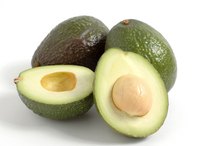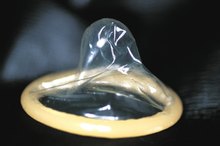Body pH & Yeast Issues
The pH of a liquid determines its acidity. By measuring how many protons, or hydrogen atoms, a chemical releases into a solution, you can determine how acidic the solution is. Acidity is measured on a pH scale, ranging from 0—highly acidic—to 14—highly alkaline or basic. Pure water is neutral, with a pH of 7. Organisms such as yeast require a specific pH range for optimal growth. If the pH balance of a part of your body is upset, you may be prone to a yeast infection.
Yeast Infection
Candida is the fungus responsible for yeast infections. A yeast infection may occur not only on your genitals but also in your mouth, on your throat, on your skin or throughout your body as a whole. Infection in the vagina or on the vulva is the most common, with 75 percent of women experiencing at least one occurrence, according to the Mayo Clinic. Candida grows in and on your body, but the presence of beneficial bacteria keeps the fungal growth in check. When the fungus overgrows, due to factors including a change in pH or antibiotic treatment that kills off your beneficial bacteria, you may suffer a yeast infection.
- Candida is the fungus responsible for yeast infections.
- When the fungus overgrows, due to factors including a change in pH or antibiotic treatment that kills off your beneficial bacteria, you may suffer a yeast infection.
Body pH
Symptoms of Lactobacillus Overgrowth
Learn More
Your body maintains an overall blood pH between 7.35 and 7.45, just above neutral, states registered dietitian Tammy Roberts 3. This pH is critical for optimal health and remains constant, with your body making physiological adjustments as needed to keep your blood pH within this range. If your body is unable to maintain its correct blood pH, such as with kidney failure, serious health consequences may result. Certain parts of your body, however, may be sensitive to external factors that affect pH. For example, hormonal fluctuations may cause the pH of your vagina to change.
- Your body maintains an overall blood pH between 7.35 and 7.45, just above neutral, states registered dietitian Tammy Roberts 3.
- This pH is critical for optimal health and remains constant, with your body making physiological adjustments as needed to keep your blood pH within this range.
Yeast and pH
Candida prefers to grow in a neutral or slightly acidic environment. The pH level of a healthy vagina ranges from approximately 4.0 to 4.5, too acidic for this fungus to proliferate in the presence of beneficial vaginal microorganisms that require an acidic environment. However, many environmental factors may cause the vagina’s pH to become less acidic, allowing beneficial vaginal bacteria to decline and Candida to thrive. These factors may include douches containing alkaline ingredients such as baking soda and hormonal changes due to ovulation or certain oral contraceptives.
- Candida prefers to grow in a neutral or slightly acidic environment.
- The pH level of a healthy vagina ranges from approximately 4.0 to 4.5, too acidic for this fungus to proliferate in the presence of beneficial vaginal microorganisms that require an acidic environment.
Other Considerations
Juicing Vegetables for Candida
Learn More
Maintaining an acidic vaginal environment may help prevent yeast infections 2. Avoid douching, as this may not only increase the pH of your vagina but also irritate sensitive vaginal tissue. Consult with your health care provider if you suspect a Candida infection.
Related Articles
References
- Frostburg State University: General Chemistry Online: What is pH?
- Feminist Women’s Health Center; Infections and Insurrection: Women Treating Yeast; Lynne Vickery
- MissouriFamilies.org; Beware of claims that you can change your blood pH; Tammy Roberts, M.S., R.D., L.D.
- “British Journal of Venereal Disease”; Vaginal pH and Microflora Related to Yeast Infections and Treatment; S. Drake et al.; 1980
- Cancer Patients and Fungal Infections. Centers for Disease Control and Prevention. https://www.cdc.gov/fungal/infections/cancer-patients.html.
- Vaginal Yeast Infections. Office of Women's Health, U.S. Department of Health and Human Services. https://www.womenshealth.gov/a-z-topics/vaginal-yeast-infections.
- Sobel JD. Candida vulvovaginitis: Clinical manifestations and diagnosis. UpToDate. https://www.uptodate.com/contents/candida-vulvovaginitis-clinical-manifestations-and-diagnosis.
- Weintrob AC, Sexton DJ. Susceptibility to Infections in Persons With Diabetes Mellitus. UpToDate. https://www.uptodate.com/contents/susceptibility-to-infections-in-persons-with-diabetes-mellitus.
- Centers for Disease Control and Prevention. Vaginal Candidiasis. Updated April 12, 2019.
- Rodrigues CF, Rodrigues ME, Henriques M. Candida sp. Infections in Patients with Diabetes Mellitus. J Clin Med. 2019;8(1):76. doi:10.3390/jcm8010076
- Centers for Disease Control and Prevention. Cancer Patients and Fungal Infections. Updated January 25, 2017.
- U.S. Department of Health & Human Services. Office on Women's Health. Vaginal yeast infections. Updated April 1, 2019.
- Cancer Patients and Fungal Infections. Centers for Disease Control and Prevention.
- Vaginal Yeast Infections. Office of Women's Health, U.S. Department of Health and Human Services.
- Atabek ME, Akyurek N, Eklioglu BS. Frequency of Vagınal Candida Colonization and Relationship between Metabolic Parameters in Children with Type 1 Diabetes Mellitus. Journal of Pediatric and Adolescent Gynecology. October 2013;26(5):257-260. doi:10.1016/j.jpag.2013.03.016.
- Sobel JD. Candida vulvovaginitis: Clinical manifestations and diagnosis.
- Weintrob AC, Sexton DJ. Susceptibility to Infections in Persons With Diabetes Mellitus.
Writer Bio
A writer since 1985, Jan Annigan is published in "Plant Physiology," "Proceedings of the National Academy of Sciences," "Journal of Biological Chemistry" and on various websites. She holds a sports medicine and human performance certificate from the University of Washington, as well as a Bachelor of Science in animal sciences from Purdue University.









